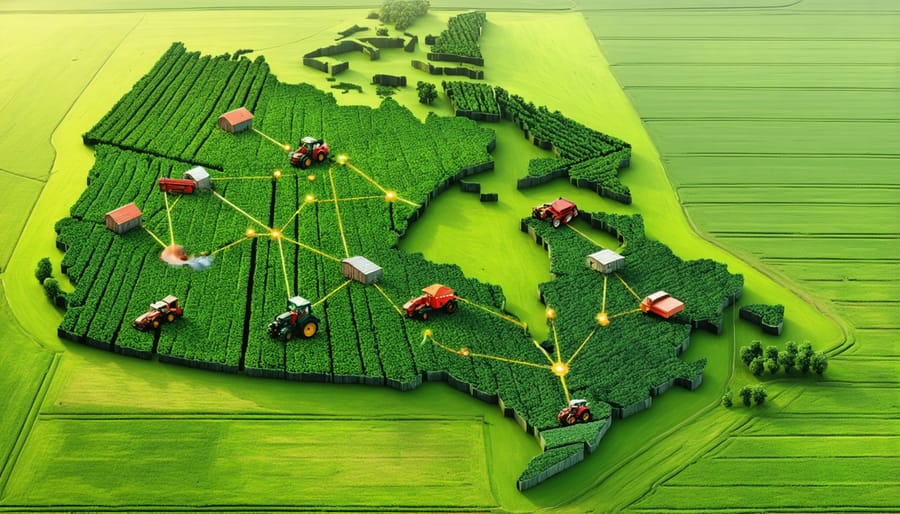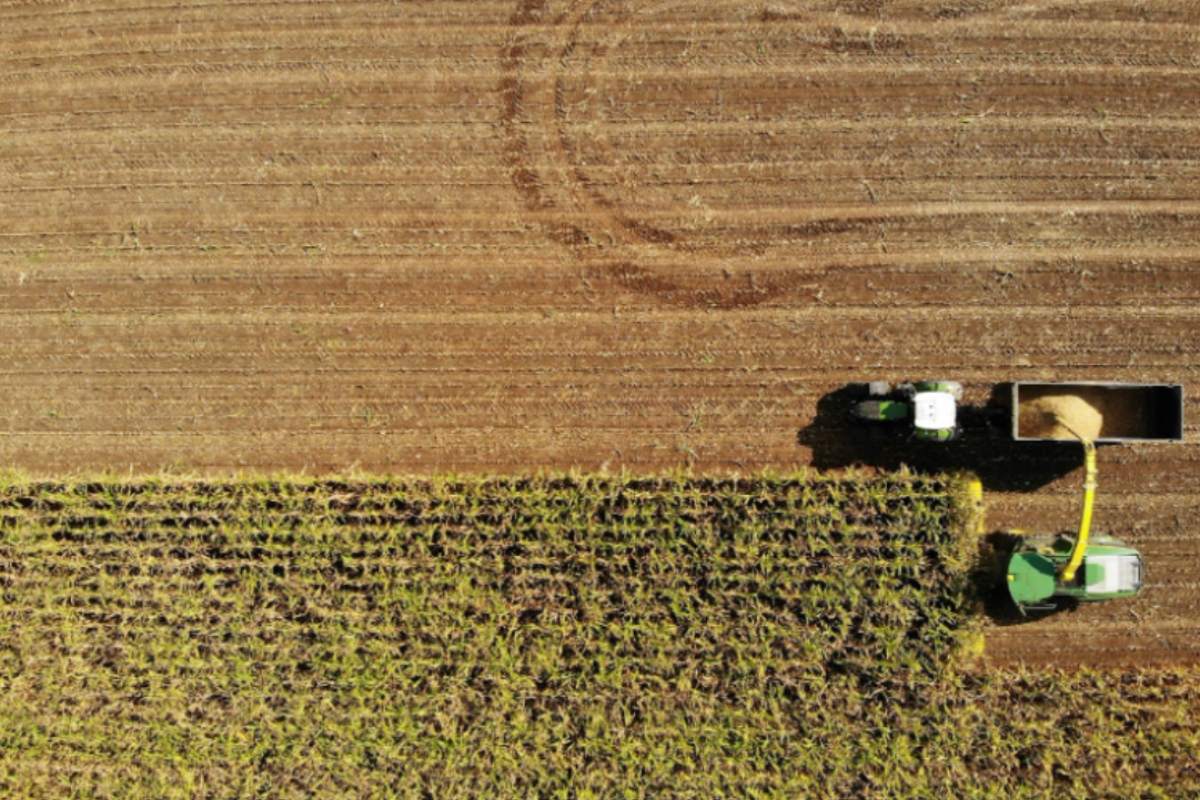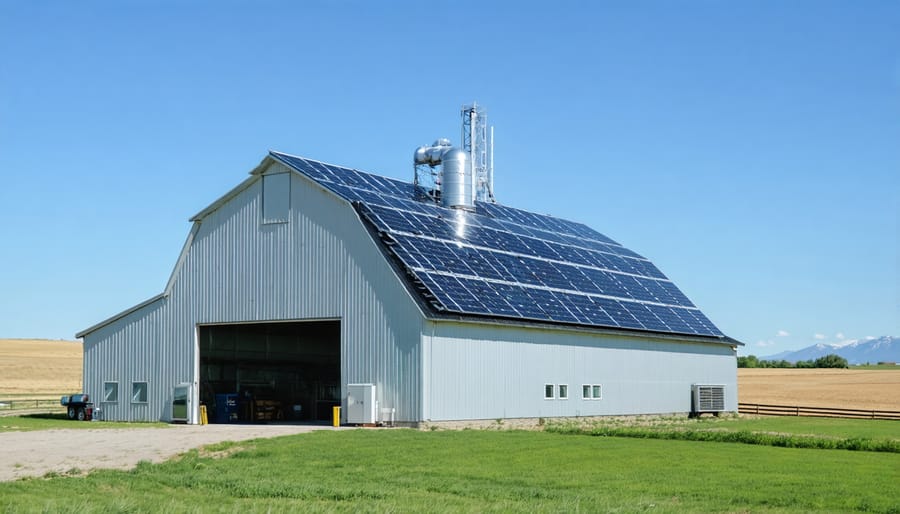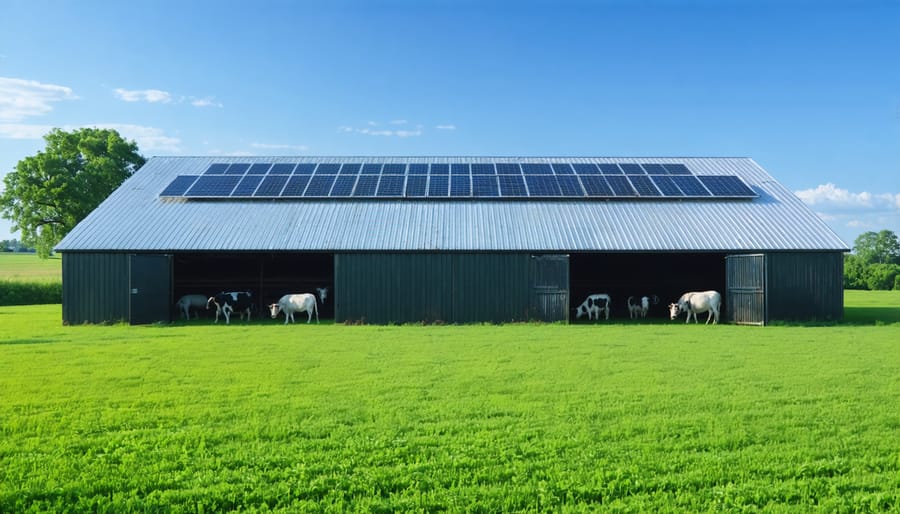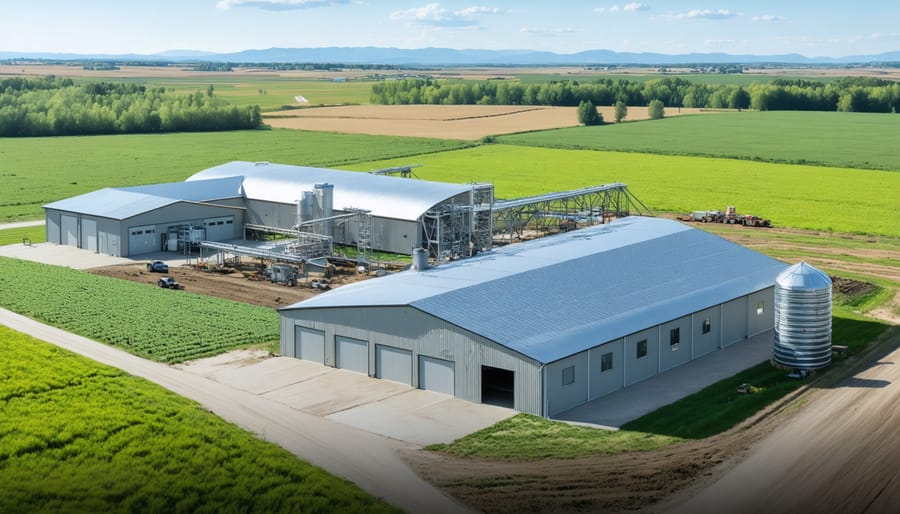Transform your supply chain vulnerability into unshakeable resilience by diversifying supplier partnerships across Western Canada’s agricultural corridor. Map every critical connection point, from seed suppliers to equipment manufacturers, identifying potential failure points and establishing backup solutions within 200 kilometers of your operation.
Canadian farmers face unique challenges that demand region-specific solutions. Recent disruptions have taught us that traditional single-source supply chains leave operations exposed to devastating interruptions. Building resilient agricultural supply networks requires a precise blend of local partnerships, technological integration, and strategic inventory management.
Strengthen your operation’s foundation by implementing real-time inventory tracking systems, establishing mutual aid agreements with neighboring farms, and maintaining strategic reserves of essential inputs. Modern farming demands the agility to pivot quickly when traditional supply lines falter, whether from extreme weather events, market volatility, or global disruptions.
This practical guide delivers battle-tested strategies from Alberta’s most resilient farm operations, combining time-honored farming wisdom with cutting-edge supply chain innovations. Every recommendation comes directly from successful implementations across the Prairie provinces, tailored specifically for Canadian agricultural conditions.
Building Local Supply Networks That Last
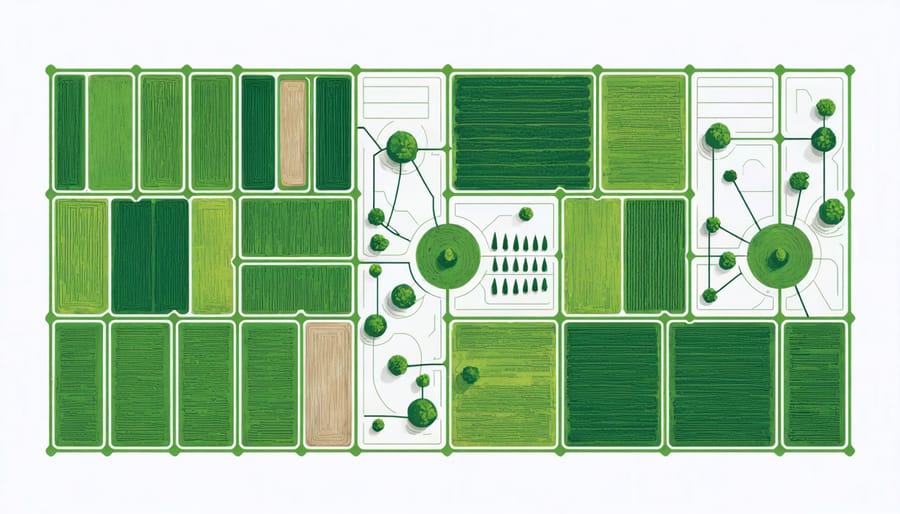
Regional Supplier Mapping
In Alberta’s diverse agricultural landscape, building strong local supplier networks is crucial for maintaining resilient farm operations. Start by creating a detailed map of suppliers within a 200-kilometre radius of your farm, including feed mills, equipment dealers, seed suppliers, and agricultural service providers. Consider joining regional agricultural cooperatives and farmer networks, which often maintain comprehensive databases of verified local suppliers.
For backup planning, identify at least two alternative suppliers for each critical input. Many Alberta farmers have found success partnering with neighbouring provinces, particularly Saskatchewan and British Columbia, to expand their supplier options. The Alberta Federation of Agriculture’s supplier directory can be an excellent starting point for discovering new regional connections.
Develop relationships with your suppliers before you need them. Schedule regular check-ins, attend agricultural trade shows, and participate in local farming community events. These connections prove invaluable during supply chain disruptions. Consider implementing a supplier rating system based on reliability, quality, and response time to help prioritize relationships.
Technology can streamline this process – use digital mapping tools to visualize your supplier network and track delivery routes. Many Alberta farmers maintain spreadsheets or use farm management software to document supplier contacts, pricing, and delivery schedules. Remember to update this information regularly and share it with key team members to ensure continuous access to critical supplies when needed.
Keep your supplier network dynamic by regularly evaluating new potential partners while maintaining strong relationships with existing ones. This balanced approach helps create a robust and adaptable supply chain that can weather various challenges.
Cooperative Purchasing Power
In today’s challenging agricultural landscape, forming or joining a farmer cooperative can significantly enhance your supply chain resilience. Alberta farmers have discovered that collective purchasing power leads to better pricing on essential inputs like seed, fertilizer, and equipment. For example, the Mountain View Farmers’ Cooperative in central Alberta successfully negotiated a 15% reduction in bulk fertilizer prices for its members last season.
Cooperatives offer more than just cost savings. By pooling resources, members can share expensive equipment, reducing individual capital investments and maintenance costs. This approach is particularly valuable for specialized harvesting equipment that might otherwise be cost-prohibitive for smaller operations.
Resource sharing extends to knowledge and expertise as well. Many successful cooperatives in Alberta have established mentorship programs, where experienced farmers guide newer members in supply chain management and risk mitigation strategies. Regular meetings and workshops facilitate the exchange of best practices and market intelligence.
Storage facilities represent another key advantage of cooperative membership. Shared grain bins and cold storage facilities can help members better time their market entry and exit, reducing dependency on immediate post-harvest sales when prices are typically lower.
To get started, connect with established cooperatives in your region or consult with Alberta Agriculture and Forestry about forming a new cooperative. Remember, successful cooperatives typically begin with a core group of committed farmers who share similar goals and values regarding supply chain management and resource optimization.
Smart Inventory Management for Alberta Farms
Digital Stock Tracking
Modern digital inventory tracking has revolutionized how Alberta farmers manage their agricultural supplies and resources. By implementing smart technology solutions, farmers can now monitor stock levels in real-time, predict supply needs, and reduce waste across their operations.
Many local farmers are using smartphone apps and cloud-based systems to track everything from seed inventory to equipment parts. These digital tools send automatic alerts when supplies run low and can even generate purchase orders based on historical usage patterns. For example, the Morrison family farm in Lacombe County reduced their seed waste by 15% after implementing a digital tracking system that monitors bin levels and coordinates with local suppliers.
RFID tags and barcode systems help maintain accurate counts of livestock feed, fertilizers, and other essential supplies. These systems can be particularly valuable during busy seasons when manual tracking becomes challenging. Additionally, integration with weather forecasting data helps farmers anticipate supply needs based on upcoming conditions.
To get started with digital tracking, consider:
– Installing inventory management apps on farm devices
– Using QR codes or barcodes for quick stock checks
– Setting up automated reorder points for critical supplies
– Implementing real-time tracking for perishable items
– Connecting with local suppliers who use compatible systems
Remember to choose systems that work well in rural areas with potentially limited internet connectivity, and ensure staff receives proper training to maximize the benefits of these digital tools.

Storage Solutions That Scale
Modern farming operations require flexible storage solutions that can adapt to varying harvest volumes and changing market conditions. Here in Alberta, we’ve seen how implementing scalable storage strategies has helped farmers maintain supply chain stability even during challenging seasons.
Start by assessing your current storage capacity and identifying potential bottlenecks. Consider implementing modular storage systems that can be expanded or modified based on needs. Many Alberta farmers are finding success with combination storage solutions – using both permanent grain bins and temporary storage options like grain bags for peak harvest periods.
Integration with modern resource management systems allows for better inventory tracking and climate control. Temperature monitoring systems and automated ventilation help maintain crop quality while reducing waste and operational costs.
Local farmer Mike Thompson from Lacombe County shares, “We installed adjustable bin systems three years ago. During last year’s bumper crop, we could quickly add temporary storage modules without compromising quality control. This flexibility helped us avoid rushed sales at lower prices.”
Consider these practical storage solutions:
– Expandable grain bin systems with modular components
– Temporary storage options for seasonal peaks
– Climate-controlled storage for sensitive crops
– Automated monitoring systems
– Strategic placement of storage facilities for efficient transportation
Remember to plan for future growth while maintaining current efficiency. Regular maintenance and upgrades of storage facilities ensure long-term reliability and protect your investment in the supply chain infrastructure.
Risk Management Through Technology
Predictive Analytics
Modern farming success increasingly relies on data-driven decision-making, especially when it comes to managing supply chains. By implementing predictive analytics tools, Alberta farmers can anticipate supply needs and potential disruptions before they impact operations. These tools analyze historical data, weather patterns, and market trends to provide actionable insights for farm management.
Local success stories, like the Thompson Valley Farm Co-op, demonstrate how predictive analytics helped them maintain stable feed supplies during the 2022 drought season. Their system flagged potential shortages three months in advance, allowing them to secure alternative suppliers and adjust their climate-resilient farming practices accordingly.
To get started with predictive analytics, farmers can:
– Monitor seasonal weather forecasts and historical patterns
– Track supplier performance and delivery times
– Analyze crop yield data from previous seasons
– Use inventory management software to predict stock requirements
– Connect with local agricultural data-sharing networks
The Alberta Agricultural Data Initiative (AADI) offers free workshops on implementing basic predictive analytics tools suitable for small to medium-sized farms. These user-friendly systems can help predict equipment maintenance needs, optimize storage capacity, and forecast potential supply chain bottlenecks with up to 85% accuracy.
Remember, successful predictive analytics doesn’t require complex technology – even simple spreadsheet tracking can provide valuable insights for supply chain planning.
Communication Systems
In today’s interconnected agricultural landscape, maintaining strong communication with suppliers is crucial for farm resilience. Alberta farmers have found success by implementing structured communication systems that keep information flowing smoothly throughout their supply networks.
Regular check-ins with key suppliers, whether through monthly video calls or quarterly in-person meetings, help build strong relationships and enable early problem identification. Many local farmers use digital platforms like WhatsApp groups or dedicated agricultural communication apps to share real-time updates about delivery schedules, weather impacts, and inventory levels.
Creating a supplier contact database is essential, including backup contacts for emergencies. Store this information both digitally and in hard copy format, ensuring access even during power outages or technical difficulties. Include critical details like preferred communication methods, time zones, and alternative suppliers for each essential input.
Consider implementing a notification system that alerts both you and your suppliers about important deadlines, upcoming orders, or potential supply disruptions. Many Alberta farmers have found success using shared calendars and automated reminder systems.
Document all communication protocols clearly, including emergency procedures and escalation paths. Make sure everyone involved in your operation understands these protocols and can access them easily. Regular review and updates of these systems, particularly before peak seasons, help maintain their effectiveness and relevance to your farm’s needs.
Remember to maintain open lines of communication with neighbouring farms as well – they can often provide valuable support during supply chain disruptions.
Environmental Sustainability in Supply Chains
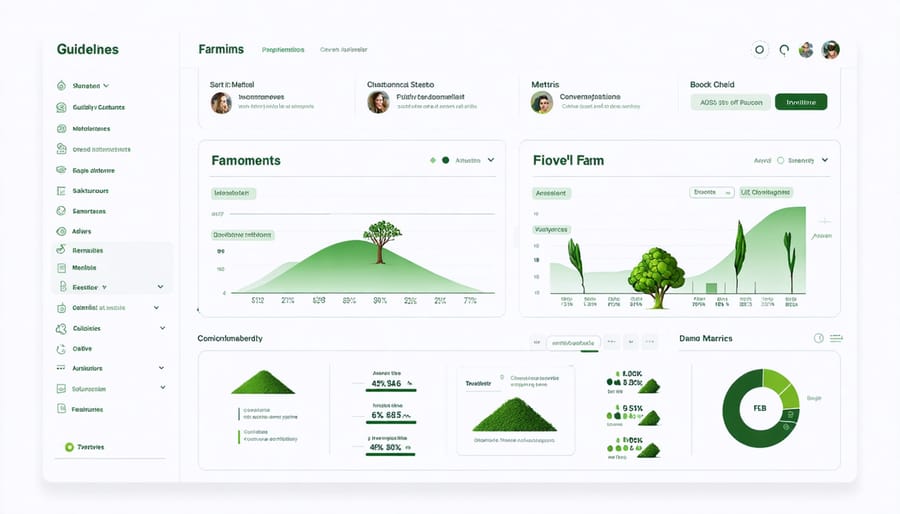
Carbon-Smart Sourcing
Reducing your supply chain’s carbon footprint isn’t just good for the environment – it’s becoming essential for long-term farm viability and market access. By implementing sustainable farming practices, Alberta farmers are leading the way in carbon-smart sourcing.
Start by mapping your current emissions across your supply chain, from input suppliers to final delivery. Consider switching to local suppliers where possible – this not only reduces transport emissions but also supports our regional agricultural community. Many Alberta farmers are finding success with cooperative purchasing groups, sharing transport costs while reducing individual carbon footprints.
Invest in fuel-efficient equipment and explore renewable energy options for farm operations. Solar-powered irrigation systems and grain dryers are becoming increasingly common across the province, offering both environmental and cost benefits. Consider using biogas from agricultural waste or implementing wind energy solutions where feasible.
Digital tools can help optimize delivery routes and reduce empty return trips. Many producers are using apps to coordinate shared transport with neighbouring farms, especially during harvest season. Remember to document your carbon reduction efforts – this information is increasingly valuable for accessing premium markets and meeting buyer requirements.
Waste Reduction Protocols
Implementing circular economy principles in your farm operations isn’t just environmentally responsible – it’s a smart business strategy that can significantly boost your supply chain resilience. Here in Alberta, we’re seeing more farmers adopt innovative waste reduction approaches that create value from what was once considered waste.
Consider starting with a comprehensive waste audit of your operation. Track material flows, identifying opportunities to reduce, reuse, and recycle. Many Alberta farmers are now converting crop residues into valuable soil amendments through composting, while others are exploring biogas production from organic waste.
Local success stories include the Lethbridge region’s collaborative grain storage initiative, where farmers share facilities to minimize spoilage and reduce storage-related waste by up to 30%. In the Red Deer area, a group of dairy farmers has established a cooperative system for processing and redistributing surplus milk products.
Remember to engage your suppliers and buyers in waste reduction efforts. Consider packaging alternatives, like returnable containers for inputs, and explore partnerships with local businesses that can use your by-products. The Agricultural Research and Extension Council of Alberta offers free consultations on implementing waste reduction strategies specific to your operation.
By building these circular practices into your supply chain, you’ll not only reduce costs but also create additional revenue streams and strengthen relationships with supply chain partners.
Building a resilient supply chain isn’t just about protecting your farm operation – it’s about strengthening our entire agricultural community here in Alberta. By implementing the strategies we’ve discussed, from diversifying supplier relationships to embracing digital tracking systems, you’re taking crucial steps toward long-term sustainability and success.
Remember that resilience isn’t built overnight. Start with small, manageable changes that make sense for your operation. Whether it’s establishing relationships with local suppliers, implementing basic inventory management systems, or joining a farmer cooperative, each step forward matters.
The future of Alberta agriculture depends on our ability to adapt and prepare for challenges. We’ve seen how our farming community’s strength lies in working together, sharing knowledge, and supporting each other through difficult times. Consider reaching out to local agricultural associations or connecting with neighbouring farms to share resources and insights.
As you move forward, focus on the strategies that align best with your farm’s unique needs and capabilities. Regular assessment of your supply chain vulnerabilities, combined with proactive planning and relationship building, will help ensure your operation remains strong and sustainable for generations to come.
Take action today – even small improvements in your supply chain resilience can lead to significant benefits tomorrow. Together, we can build a more resilient agricultural sector that continues to feed Canada and the world.

